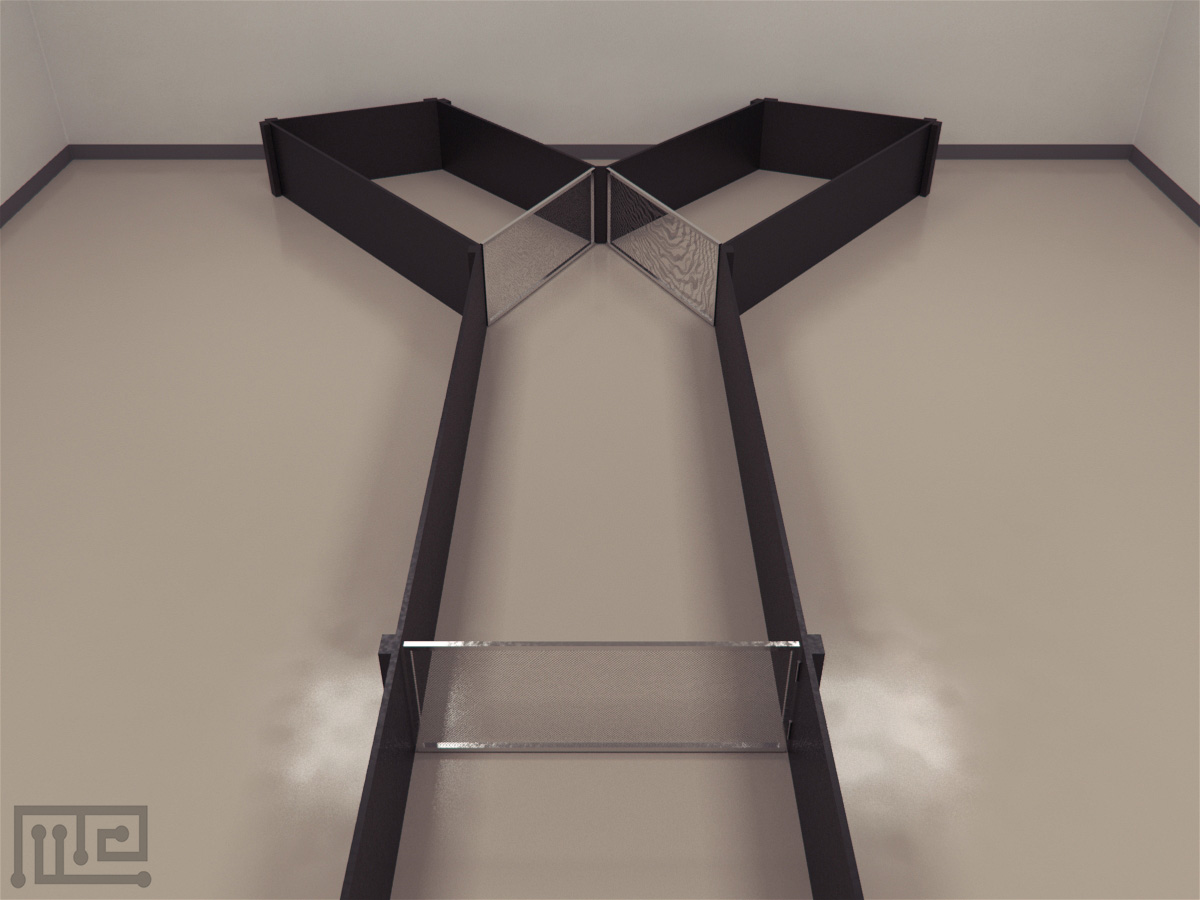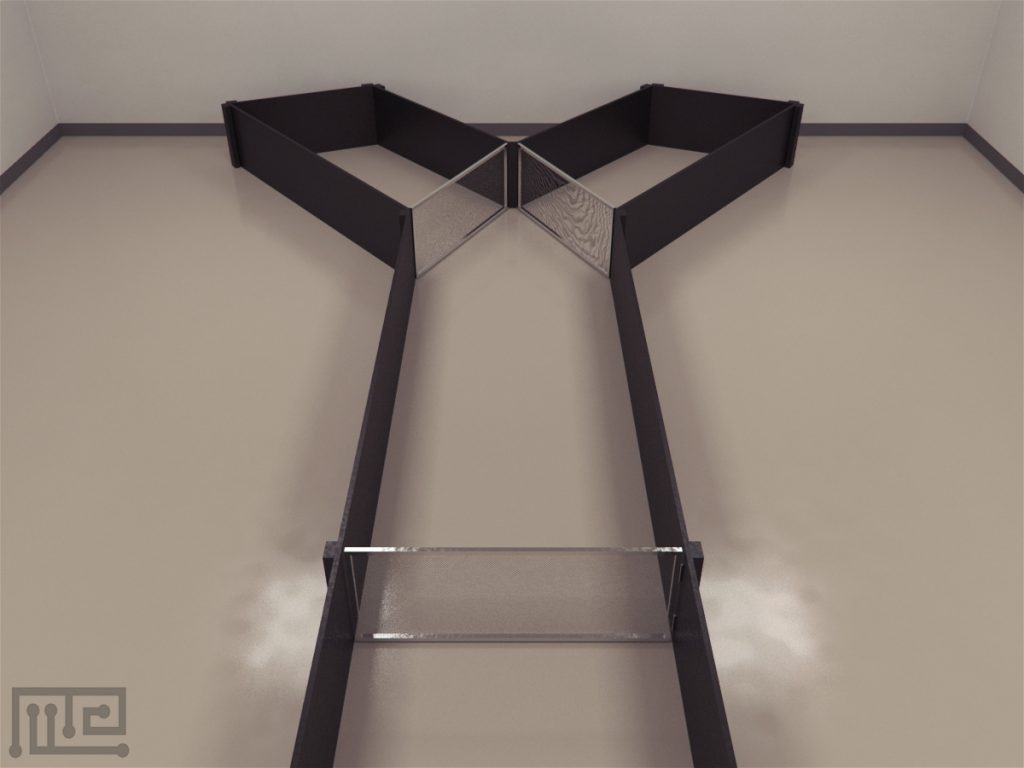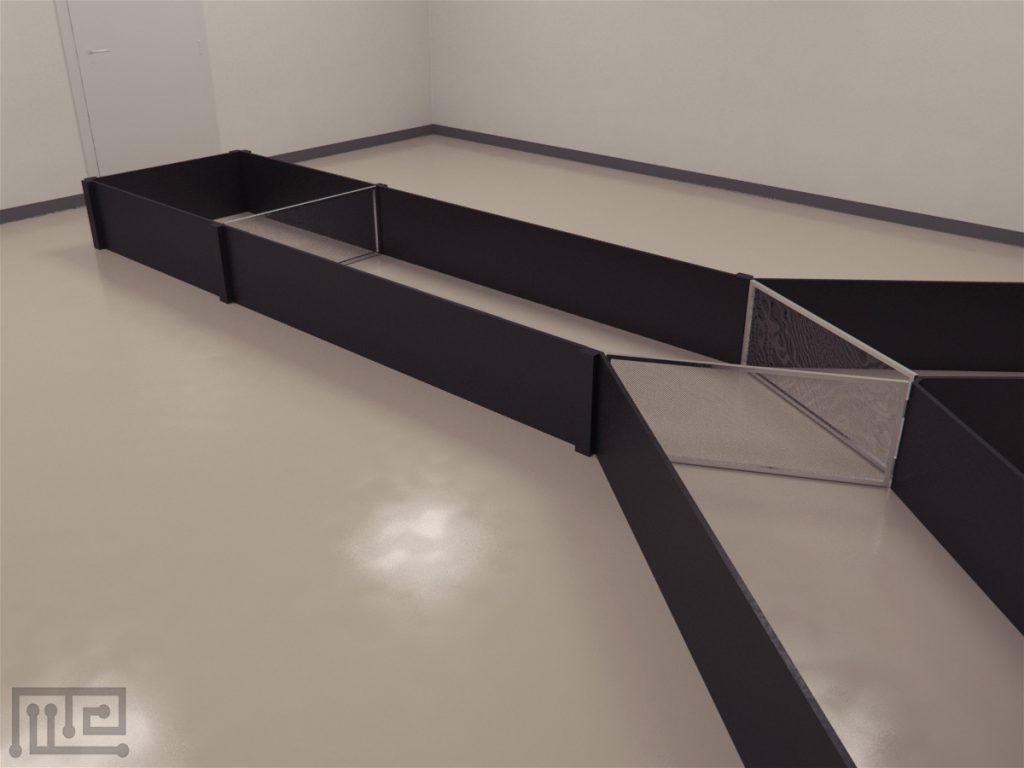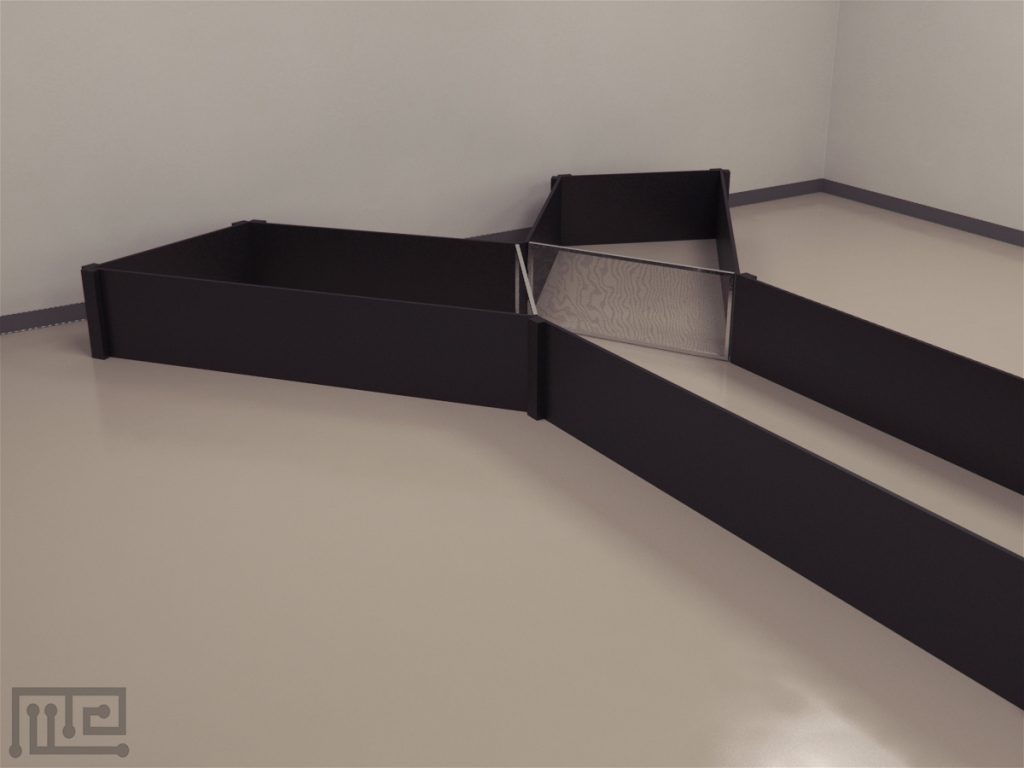The Pig Y-maze is a purpose built apparatus with solid walls and a concrete floor. It was used by Paul H. Hemsworth et al.(2011), to examine effects of deprivation of feed, social contact and bedding on the choice behaviour of pigs in Y maze tests.
The pigs in the start-box could see the choice options located at the ends of the short arms. Pigs were held in the start box for 5 s before testing and were allowed 2 min in the short arm chosen in each trial. Thus depending on the short arm entered, pigs had either unrestricted access to feed or bedding or the opportunity to physically interact with the stimulus pigs through a mesh gate.
Mazeengineers offer the Pig Y-maze.
Price & Dimensions
Pig Y-maze
$ 1990
+S&H- Length of start-box: 2m
- Width of start-box: 1.5m
- Length of two short arms: 2m
- Width of two short arms: 1.5m
- Length of long arm: 3m
- Width of long arm: 1.5m
Documentation
Introduction
The Pig Y Maze is a modification of the rodent Y maze to study choice behaviors in pigs. It was first devised by Hemsworth et al. (2011) to investigate the choice behavior of pigs upon deprivation of resources.
The Pig Y Maze is a simple apparatus to understand the choice behavior of subjects in the presence of different cues. It is composed of a longitudinal arm joined together with two short arms to create a “Y” shaped apparatus. The Pig Y maze is also provided with a start box that acts as an isolation area for the subject. This isolation area is separated from the choice area with the help of transparent dividers. Different cues can be placed within both choice arms, and the subject can choose to enter any of the two choice arms based on its relative preference towards the cue. The Pig Y Maze can be used to observe preference to the resources by depriving access to different resources like feed, bedding, and social contact (Hemsworth et al. 2011). Studies have reported that different resources have different stimulus values, and pigs choose a resource based on its relative preference towards a resource (Matthews & Ladewig, 1994). Pig Y Maze can be used to assess other behaviors like social discrimination and recognition learning. (Gieling, Nordquist, & van der Staay, 2011). It can also be used to assess the effect of diseases and disorders on learning, memory, and choice behaviors in pigs.
Other apparatuses used for behavioral assessment in pigs include the Pig T maze, the Pig Hebb-Williams Maze, and the Pig Conditioned Place Preference Chamber.
Equipment and Apparatus
The Pig Y maze is composed of a start box, a longitudinal arm, and two short arms. The start box (2 m in length and 1.5 m in width) is separated from the longitudinal arm (3 m in length and 1.5 m in depth) of the maze with the help of a transparent divider. At the end of the long arm, there are two short arms (2m in length and 1.5 m in width) separated from the long arm with the help of transparent dividers. The walls of the arms are solid black in color, while dividers are transparent.
Training protocol
Clean the apparatus before each trail. Properly lit the apparatus. A tracking and recording system such as the Noldus Ethovision XT can be used to assist with observations.
Pretraining
Introduce the subject to the start box of the empty Pig Y Maze for 5 seconds. Remove the transparent divider and then allow the subject to explore the maze for 2 minutes. Return the subject into its home pen. Now place two different cues in each short arm and introduce the subject in the start box for 5 seconds. Allow access to one short arm of the maze for 2 minutes. After 2 minutes, place the subject back to the start box for 5 seconds. Now allow access to the other short arm for 2 minutes. After completing the trail, remove the subject and place it into its pen. Conduct each trail twice daily for two days.
The Pig Y Maze task
Place the subject in the start box for 5 seconds. After 5 seconds, allow the subject to choose and enter one of the two short arms provided with cues. Close the divider of the other arm to restrict the subject to enter the other short arm. After 2 minutes, remove the subject from the maze and place it into its home pen. Conduct trial daily for 12 consecutive days.
Resource preference task
Place the subject in the start box for 5 seconds. After 5 seconds, allow the subject to choose any of the two short arms provided with two different resources. Once the subject enters one arm, close the divider of the other arm to restrict the subject to enter the other short arm. After 2 minutes, remove the subject from the maze and place it into its home pen. Conduct trial daily for 12 consecutive days.
Literature Review
Investigation of resource deprivation on choice behavior of domestic pigs
Hemsworth et al. (2011) investigated the impact of resource deprivation on the choice behavior of Sus scrofa (n=80). The study reported the role of food, bedding, and social contact deprivation on the choice behavior of pigs for these resources. The choice behavior towards these resources was tested using the PigY Maze. The study involved three experiments. The experiment one (n=16) was carried out to test the impact of the feed (voluntary food intake vs. 70% voluntary food intake) and bedding (presence vs. absence) on the choice behavior of pigs. The experiment two (n=16) was conducted to test the social contact (full social contact vs. restricted social contact) and bedding(presence vs. absence). Experiment three (n=48) was carried out to look for the impact of feed (voluntary food intake vs. 70% voluntary food intake) and the social contact (full social contact vs. restricted social contact) on choice behaviors of pigs. A 2 × 2 factorial design was used to look for the effects of treatments in each experiment. Before experimentation, the pigs were pretrained for a week. After one week of training, the pigs were subjected to daily sessions of the Pig Y maze to look for the impact of treatments. The results of the experiment one stated no significant effect of feed (p>0.05) and bedding (p>0.05) on the choice behavior of pigs. There was also no significant interaction between feed and bedding. The pigs preferred feed over bedding in most of the trails. There was also no significant effect of bedding and feed on the time taken to approach within 5 cm of the feed(p>0.05) and time spent within 5 cm of feed (p>0.05). It was observed that restrictively fed pigs with bedding move toward the feed faster than those without bedding (0.02 min vs. 0.10 min). The results of the experiment two stated no significant effect of social contact (p>0.05), but a significant effect of bedding (p<0.05) was observed on the choice behavior of the pigs. There was also no significant interaction between social contact and bedding (p<0.05). The pigs preferred social contact over bedding in most of the trails. There was also no significant effect of social contact and feed on the time taken to approach within 5 cm of the feed(p>0.05) and time spent within 5 cm of feed (p>0.05). Lastly, the results of the experiment three stated no significant effect of social contact (p>0.05), but the significant effect of feed (p<0.05) on the choice behavior of pigs. There was also no significant interaction between feed and social contact (p<0.05). The pigs with restricted feed preferred feed over social contact. There was also no significant effect of social contact and feed on the time taken to approach within 5 cm of the feed(p>0.05) and time spent within 5 cm of feed (p>0.05). The deprivation of both feed and social contact significantly reduced average daily gain. The social effect was attributed to the stress caused by social deprivation. This study concluded that pigs prefer feed and social contact over the bedding. However, they preferred social contact (63% trails) over feed. The results of the study do not support the idea of disruption in biological function due to the restriction of preferred resources in pigs.
Data Analysis
- Number of times subject chose cue in the left arm
- Number of times subject chose cue in the right arm
- Time taken to approach within 5 cm of the cue
- Time spent within 5 cm of the cue
Strengths and Limitations
Strengths
The Pig Y Maze is a simple apparatus, and the task is easy to perform. The presence of transparent dividers creates isolation areas that help to restrict unwanted interaction of subjects with the cues. The Pig Y Maze can be used to study different behaviors such as resource preference, social discrimination, and recognition learning.
Limitations
The subjects require extensive pretraining before experimentation. The presence of unsolicited auditory, olfactory, or visual stimuli may alter observations. In the tasks involving food stimuli, the type and amount of food can influence task performance. Task performance is time-consuming. Factors such as age, gender, and strain of the subject may affect task performances.
References
- Hemsworth, P. H., Smith, K., Karlen, M. G., Arnold, N. A., Moeller, S. J., & Barnett, J. L. (2011). The choice behavior of pigs in a Y maze: effects of deprivation of feed, social contact and bedding. Behavioral processes, 87(2), 210–217. https://doi.org/10.1016/j.beproc.2011.03.007
- Gieling, E. T., Nordquist, R. E., & van der Staay, F. J. (2011). Assessing learning and memory in pigs. Animal cognition, 14(2), 151–173. https://doi.org/10.1007/s10071-010-0364-3
- Matthews, L. R., & Ladewig, J. (1994). Environmental requirements of pigs measured by behavioral demand functions. Animal Behaviour, 47(3), 713–719. https://doi.org/10.1006/anbe.1994.1096
Request a quote
"*" indicates required fields




